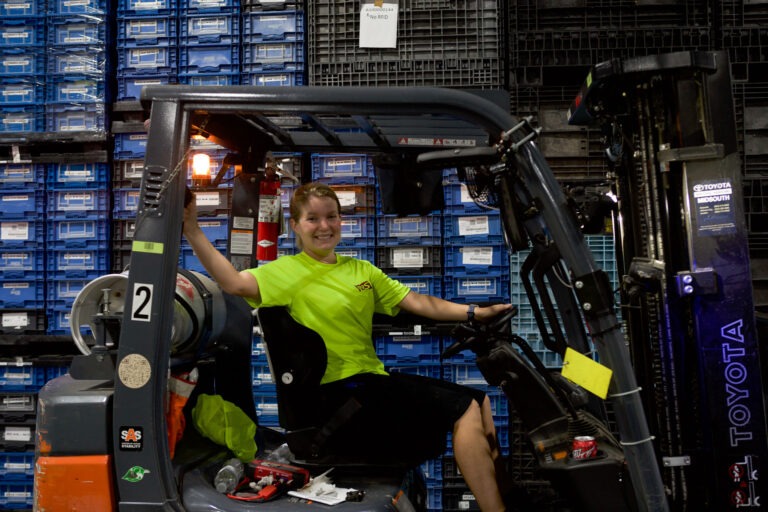AI is everywhere these days, and no surprise here, the logistics industry is no exception! In particular, artificial intelligence is transforming how we think about warehouse inventory management. While many tasks in warehousing remain manual, technology is increasingly at the heart of operations, enhancing efficiency, accuracy, and responsiveness.
AI is transforming inventory management for warehouses, addressing challenges such as demand forecasting and stock balancing. By blending AI with human capital, R&S delivers flexible, efficient inventory management, meeting your needs in modern-day warehousing.
Count ‘Em Up: The Challenges Facing Warehouse Inventory Management
It seems simple, right? Managing inventory should just be keeping track of how many products are on the warehouse shelf. But when you consider that many industries have weeks- or even months-long supply chain processes, it’s easier to appreciate the complexity of demand forecasting. Predicting customer demand accurately requires analyzing vast amounts of data, including historical sales, market trends, and external factors like economic conditions. This complexity often leads to imprecise forecasting.
Balancing stock levels is another challenge. Maintaining the right inventory levels to avoid overstock and stockouts is critical but difficult. Overstock ties up capital and storage space, while stockouts can lead to lost sales and dissatisfied customers.
Seasonal fluctuations and market trends further complicate inventory management. Seasonal demand can vary dramatically based on sudden market shifts and even stock market changes. This requires agile and responsive inventory strategies.
Managing diverse product ranges and SKUs also adds to the complexity. Warehouses often handle thousands of different items, each with unique storage and handling requirements. This diversity makes it challenging to maintain accurate inventory records and efficient retrieval processes.
AI Technologies Transforming Inventory Management
AI is revolutionizing inventory management through a variety of innovative applications. In fact, AI-enabled supply chain management has improved inventory levels by 35%. This is due in part thanks to machine learning algorithms, computer vision, technology, and natural language processing.
Machine learning algorithms analyze historical data, market trends, and external factors, providing highly accurate demand forecasts. This enables your business to optimize stock levels and reduce overstock and stockout situations.
Computer vision technology is transforming real-time inventory tracking by using cameras and image recognition to:
- Monitor stock levels
- Identify products
- Detect discrepancies
This ensures up-to-date inventory information without manual counting.
Natural language processing facilitates streamlined communication within the supply chain by interpreting and generating human-like text. It can automate order processing, handle customer inquiries, and improve coordination between different departments.
Enhanced Order Fulfillment through AI
AI enhances order fulfillment for warehouse inventory management by optimizing picking routes and strategies. It analyzes warehouse layouts, product locations, and order details to determine the most efficient paths for pickers. This minimizes travel time and increases productivity.
AI-driven automated sorting and packing processes also improve accuracy and speed. These systems can identify, sort, and pack items with minimal human intervention, reducing errors and processing time.
Another benefit of AI algorithms is leveraging predictive shipping to anticipate customer orders based on historical data and market trends. This allows warehouses to preemptively position inventory, leading to faster delivery times.
At R&S Logistics, we leverage AI to improve order accuracy by implementing computer vision technology for real-time inventory tracking and matching order requests with picked inventory. This reduces the likelihood of shipping incorrect items or quantities to customers.
Integrating AI-powered solutions makes managing warehouse inventory more efficient, accurate, and responsive. By meeting customer demands, AI ultimately enhances your overall order fulfillment performance.
The Future of AI in Warehousing
Warehousing AI may provide significant advancements across various dimensions in the future. Predictive analytics has the potential to play a crucial role in proactive inventory management by analyzing historical data and market trends to forecast demand accurately. This may help reduce both overstock and stockouts.
Process automation and robotics integration may also further enhance efficiency. Advanced AI-driven robots could be able to handle tasks such as pick and pack fulfillment and transport goods autonomously, reducing errors and increasing productivity. Generative AI may help optimize warehouse layouts and reinforcement learning for constant improvement in processes.
The Internet of Things (IoT) could provide real-time data collection through interconnected sensors and smart devices. With IoT, AI systems have the potential to continuously monitor and optimize warehouse operations. This integration will lead to more responsive and adaptive environments.
Together, these technologies may play a major role in transforming warehouses into highly efficient, adaptable, and sustainable hubs. They’ll help set new standards in logistics and supply chain management.
The Human Touch in AI-Driven Warehousing
At R&S, we value innovation and we’re ready to jump in when you’re ready to take the next step. We help you be agile and reliable as you adapt to changing demands for your products.
While AI is revolutionizing warehouse inventory management, the human touch remains crucial. Our people matter deeply to us. We wouldn’t be here without them. Too, with such complex scenarios, our people are what help us solve the most critical problems and identify opportunities to grow, scale, and get better.
For instance, shipping non-standard products often requires manual handling due to their unique characteristics or fragility. Examples include delicate scientific equipment or custom-built machinery that doesn’t fit standard packaging protocols. Human expertise and human hands are essential in these cases, as AI systems may struggle to adapt to such irregularities.
We leverage technology and the power of AI to help our teams move faster, work smarter, and free up their time for what’s most important for our customers. This approach ensures that they can:
- Interpret AI-generated insights
- Make nuanced decisions
- Intervene when necessary
By fostering this combination of AI and human expertise, we maintain flexible inventory management, addressing both routine operations and exceptional cases with equal proficiency.
Partner with R&S to Take Your Business to the Next Level
R&S Logistics is implementing AI technologies to revolutionize our warehouse operations and better serve you. By adopting machine learning algorithms for demand forecasting, we can more accurately predict your inventory needs, reducing both overstock and stockouts.
AI implementations like these help you by:
- Optimizing order fulfillment
- Reducing errors
- Speeding up delivery times
- Traceability for your products and shipments
We recognize that adapting to AI in the warehousing industry helps us stay competitive and meet your evolving expectations. By embracing these technologies, we’re positioning you and ourselves at the forefront of modern warehouse management, ensuring improved efficiency, accuracy, and responsiveness in an increasingly complex supply chain environment.

AI is changing inventory management by tackling challenges like demand forecasting and stock balancing. Although AI improves operational efficiency, people are essential for handling unique scenarios. By integrating AI with human capabilities, we provide flexible and efficient inventory management that meets your requirements in today’s warehousing landscape.


